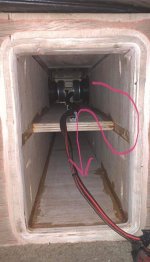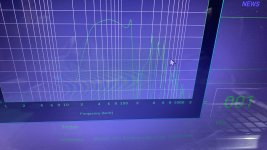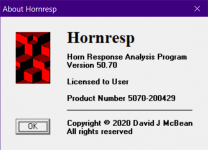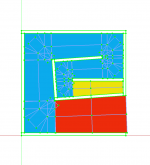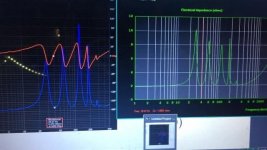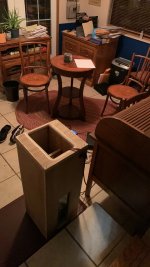If you build these another way there’s none of that funk those exihibit. The same area that the little 3Fb overlap is made ‘optimal’ in the offset driver transmission line too. I’m always concerned with it in either because I understand how bad it made the 3 Paraflex I built ??Wtf? So it's not the published graph? The one they show don't have that disturbance in the force 🤣
Attachments
Nice! I notice that you used a newer version of spreadsheet than in your web would you care to upload ? Thanks ,
If you build these another way there’s none of that funk those exihibit. The same area that the little 3Fb overlap is made ‘optimal’ in the offset driver transmission line too. I’m always concerned with it in either because I understand how bad it made the 3 Paraflex I built ??
Errrr, i can help to install the screen capture utility on you machine,
🙂
I think he prefer to use the smartphone to post screens capture in the forum. But it isn't good for communication.
There is a cross platform software (Windows/Linux) very nice and useful called KDE Connect, you can take and screen shot on computer and very fast send to the phone and vice versa. There are a lot more utilities, you can search for youtube video to find out.
ok it was this one
and yes the graph looks strange but i think is what it is with that driver
thing is that maybe that strange look on the graph will be not noticeable
View attachment 1129620
Looks like a B0$3 WC response to me.
More TL and OD TL stuff…. Brian likes these types of subs, I hope he doesn’t mind
Those enclosures look like THs and not TLs. It would be interesting to see how they measure when built. I bet they have a BP6S type response vs a BR type response.
Last edited by a moderator:
A tapped horn is a series 6th order bandpass enclosure.
I can model a straight (zero) flare TH with either the TH or BP6S function in HR and get the same results.
Show me a TH that can be modeled as a TL and get the same results?
I can model a straight (zero) flare TH with either the TH or BP6S function in HR and get the same results.
Show me a TH that can be modeled as a TL and get the same results?
you can easily see that a TH is a BP6S
Guess the patent guys, and Danley, did not notice that when he got a patent on the tapped horn.
dave
I apologize planet10!
TH, BP6S, and ODTL are the SAME!
Brian Steele is right, ODTL is the way to go when it comes to speaker mounting and modeling.
I think the TH and BP6S will sound better since the speaker is hidden in the enclosure.
TH and BP6S have better speaker protection.




TH, BP6S, and ODTL are the SAME!
Brian Steele is right, ODTL is the way to go when it comes to speaker mounting and modeling.
I think the TH and BP6S will sound better since the speaker is hidden in the enclosure.
TH and BP6S have better speaker protection.
Its like saying: all squares are rectangles but not all rectangles are square. Square is a special case of rectangle when all sides are equal.
So TH looks like a special case of BP6S, when you basically the front chamber and the front port has the same cross section area and the second chamber has no port or you can say the port also has the same cross section area of the chamber but the length is 0.
You can play around with model but the result will be same.
See attached illustration.
The front chamber (yellow) is serial connected to the port (blue) witch is serial connected to the rear chamber (red) witch has no port.
front and rear chamber share the same driver. So TH and BP6S are equivalent in this case.
They can be flared or not, it doesn't matter.
So TH looks like a special case of BP6S, when you basically the front chamber and the front port has the same cross section area and the second chamber has no port or you can say the port also has the same cross section area of the chamber but the length is 0.
You can play around with model but the result will be same.
See attached illustration.
The front chamber (yellow) is serial connected to the port (blue) witch is serial connected to the rear chamber (red) witch has no port.
front and rear chamber share the same driver. So TH and BP6S are equivalent in this case.
They can be flared or not, it doesn't matter.
Attachments
uh ??? now i am completely F..up. so if all the designs are the same
what is the easiest to work with or tweak with.
what is the easiest to work with or tweak with.
A sealed box with a dsp and lots of headroom to tweak it (large xmax/Bl70%) driver into ‘any’ response .
😝
😝
What is ‘Br response’? Vs ‘od MLTL’ response ?Those enclosures look like THs and not TLs. It would be interesting to see how they measure when built. I bet they have a BP6S type response vs a BR type response.
Ok let me rephrase , what is the design that squeeze up to the last drop of SPL. For any given driver.
Assuming TS parameters that dont ‘suck’ , then A 3:1 folded parallel qw pipe with exactly the 3:1 resonators length ratio to the same exit. Not much else to be done with closed end pipes (1/4,3/4,5/4 resonances) and ‘SPL’ Unless you want a one or two note(spike at resonance with nasty ‘Q’ ) blunder (poorly sized results in a whistle or ringing or 1,3,5…..x the Fb spikes ?)Ok let me rephrase , what is the design that squeeze up to the last drop of SPL. For any given driver.
unless you screw it up with random folding and resonator length that don’t arrive together ) at an exit that sits on the odd harmonic interval (3:1) , it’s potent and clean. It seems to be the ‘loudest’ and widest’ BW of them all for a reason
Attachments
Last edited:
Probably 8th order bandpass 🙂
Seriously, there's usually more conditions involved than peak SPL when choosing a design. Portability, for one.
Seriously, there's usually more conditions involved than peak SPL when choosing a design. Portability, for one.
- Home
- Loudspeakers
- Subwoofers
- Big, big TL...
